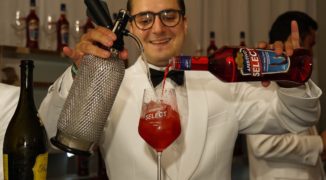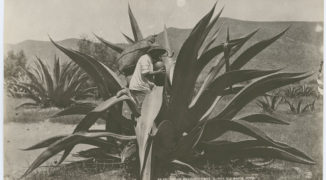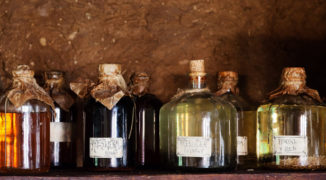In 1934, R. Fleury published a book called “1700 Cocktails for the Man Behind the Bar.” The book contained a recipe for a cocktail called the Carrol, recommending a pickled walnut as appropriate garnish. Nearly 100 years later, Richard Boccato co-owner of and partner in Fresh Kills (which opened at the end of March), Dutch Kills and Hundredweight Ice, came across the garnish and found a distributor who could import pickled walnuts from the United Kingdom.
Instead of adding the Carrol to his menu, however, Boccato selected the Dragon’s Breath from the same book, which includes Calvados, dry vermouth, apricot liqueur and a hint of hot sauce, for the Fresh Kills menu. He serves the pickled walnut on the side, and a citrus twist rests inside the glass. “What our guests choose to do with that pickled walnut is entirely their prerogative,” he says.
Boccato started with a curiosity about what a pickled walnut tasted like. He paired the walnut with the Dragon’s Breath because the malt vinegar used for pickling “complements the slight heat on the back end of the palate of the cocktail,” he says.
Although he is currently importing his walnuts, Boccato hopes to be more hands-on in the future. “My goal is to find some fresh green walnuts in season and pickle my own,” he says.
Cocktail garnishes first made an appearance in print in the first known cocktail book, Jerry Thomas’ “How To Mix Drinks,” or “The Bon-Vivant’s Companion,” published in 1862. Although Thomas is occasionally specific (he recommends topping a Brandy Flip with a toasted cracker with nutmeg freshly grated on top and suggests that the fresh-cut rind of a cucumber be added to a Porter Cup), most of the time he recommends fruit or berries “in season” when ornamentation is called for and lemons when in need of citrus.
Not only do his recipes call for citrus juice and the peel for garnish, but he often references rubbing parts of the glass with the rind first. Josh Goldman, co-founder of the Soigné Group, postulates that this stems from a specific historical mindset. “We throw away so much now,” he says. “Our ancestors wanted to use everything. It’s very easy for us to obtain things, but it wasn’t easy for them. So if you had a lime, that meant something. If there was a way of getting the oils and the zest, they did it.” This also meant that people needed to make sure that nothing went bad. “The pickling thing is basically a way to preserve,” says Goldman. “If you don’t pickle peanuts, boil peanuts, pickle walnuts, or whatever, they’ll eventually turn rancid and spoil. So that’s why there’s pickled eggs and all sorts of different things.”
Adam Seger, Master Barman for IPIC Entertainment, loves the movement toward homemade ingredients and locally sourced garnishes, reminiscent of the early days of cocktails. “People choosing to do this when there’s availability of all manner of purchased shortcuts? It’s really exciting,” he says. But he is quick to point out that the local, seasonal focus of the past came from necessity rather than desire. “Pineapple, this was something from outer space. Fresh pineapple in the 1700s would be like getting your hands on a dragonfruit or a fresh yuzu now.”
Jam was another garnish for punch and cocktails. “That would have been the way to pull in berries or stone fruit because that season was so short, it wasn’t like ‘well, okay, it’s wintertime, I’ll just get them from South America now and next time they’re coming from Asia,’” says Seger. Still, he considers the vintage way to be the best philosophy. “It’s garden to glass, three hundred years ago.”
At Café Standard, located in the Standard Hotel in New York City, bartender Damiano Coren is pickling strawberries to garnish a drink with Amaro Lucano, local apple juice, strawberry shrub, egg white and chocolate mole bitters (aptly named Strawberry Fields). Although the pickled strawberry doesn’t appear in a book as far as he knows, the idea comes directly from the days of a short strawberry season and a desire to taste summer all year round. Coren only allows his strawberries to soak in an apple cider vinegar mixture for a couple of days so that the outsides are pickled, but the insides are fresh, perhaps the best of all possible worlds.
Coren pointed out that William Schmidt suggests using canned fruit in place of fresh, when unavailable, as a garnish, or for juice, in his 1892 book “The Flowing Bowl.” In his section on fruit, he mentions lemons, oranges, “the delicious pineapple,” “choice grapes,” and strawberries, raspberries and cherries. No limes to be seen.
“At one time the olive and the cherry and pickled onion and everything like that that was new,” says Goldman. “Keep in mind the straw was macaroni at one time. That was a brand new invention.”
Another important garnish came in the form of spices. “Very rich aristocrats used to have silver nutmeg shavers that they carried with them,” says Goldman. He notes that while cocktail garnishes were first mentioned in Thomas’ book, they actually go back much further than that, to the predecessor of the cocktail: punch. “Now you can go to any grocery store anywhere and get nutmeg, but that was incredibly rare back in the day. Sailors that were drinking punch wouldn’t necessarily have nutmeg.” Along those same lines, Seger points out that sugar was used as currency for a significant period of time. A drink like the Brandy Crusta, which boasted a thick coating of sugar, showed off status.
Seger suggests that a combination of egg whites and bitters might have functioned as early garnishes as well. “Egg whites are a great platform for bitters which can be quite beautiful depending on how you do your dashes on top of a cocktail. There’s not really a lot written on it but you would think as many vintage drinks that had egg whites and bitters that would have been something that bartenders would have started to kind of play with, almost like you see baristas now with gorgeous lattes and cappuccinos.”
It’s possible that a cigarette might have served as an unofficial cocktail garnish, without the bartender’s consent. Julie Janides, bartender at Burlock Coast in the Ritz-Carlton, Fort Lauderdale, is playing with that idea by creating a “cigarette” out of a rustic orange peel (rolled using a family-taught technique). She fills the peel with local, edible potpourri. James Camp, Burlock Coast’s Beverage Manager, says that this is a nod to hotel history. “It was common in great, grand hotels of the late 1800s, having the potpourri scattered throughout the banquet halls, scattered throughout the dining sessions. We’ve taken a part of hotels during the golden age of cocktails and applied it to cocktails and hotels during the second golden age of cocktails.”
Camp is more interested in creating an excellent guest experience than in pursuing something vintage for the sake of it. For him, it’s all about whether or not it’s good. “When you can get good and local or good and vintage, it’s really wonderful,” he says.
Goldman cautions against adding vintage (or any) garnishes to your program just for the Instagram photos. “If the garnish is an extension of your ego, I don’t think you’re serving the drink. If the garnish is a natural extension of the drink and it enhances your guest’s pleasure of that drink then I think ‘yeah, fire on all cylinders, blow our minds. Get us talking about it.’”
Philip Dobard, Vice President of the National Food & Beverage Foundation, President of the Pacific Food & Beverage Museum and Director of The Museum of the American Cocktail, points out that many people have come to associate a specific garnishes with drinks, but that for a truly vintage experience, that wouldn’t be the case. “Garnishes didn’t become codified for some time,” he says. “The tradition is what’s in season or what’s been pickled, what’s been preserved, and second, what of those things is going to compliment the flavor profile of this drink?”
“History is created on the fly,” says Dobard. “Then there are people who get their minds around it, and then they codify things and some of them become dogmatic and that ruins it for the rest of us.”
Boccato is reluctant to suggest that other bartenders follow his example, either with pickled walnuts or vintage garnishes in general. “I would recommend that other bartenders apply the garnishes that they feel best represent their cocktails. I wouldn’t be able to say with any degree of certainty whether or not a vintage one has any more relevance than something modern. I just do what works for me.”





